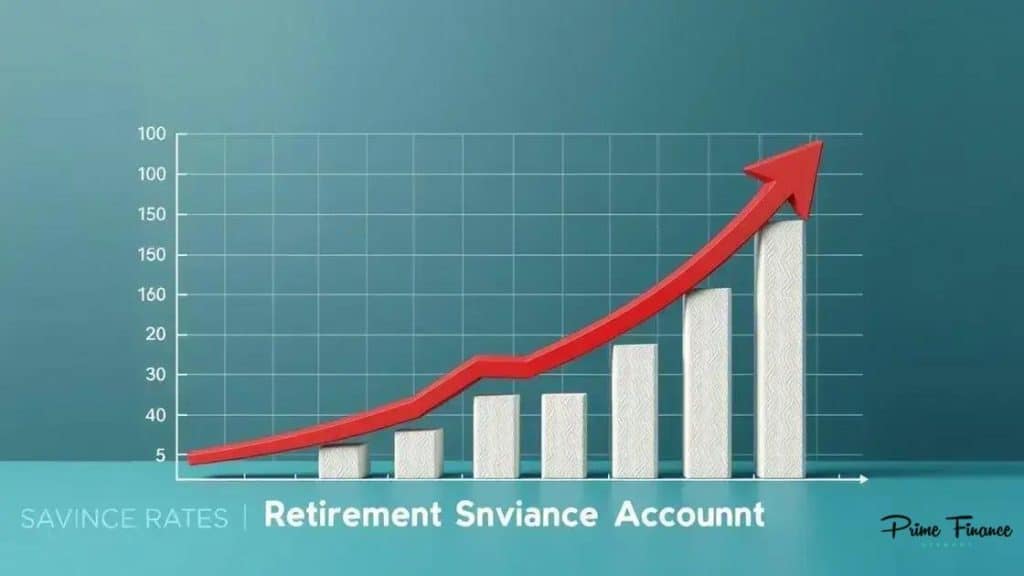Impact of inflation on retirement savings accounts

The impact of inflation on retirement savings accounts reduces their purchasing power, making it essential to adopt strategies like diversification and budgeting to protect your financial future.
Impact of inflation on retirement savings accounts is something many don’t consider until it’s too late. Are you prepared for how inflation can erode your hard-earned savings? Let’s dive into this important issue.
Understanding inflation and its effects
Understanding inflation is essential for anyone planning for retirement. It directly impacts your savings and purchasing power over time. As inflation rises, it can weaken the value of your retirement funds, making it vital to grasp how these economic changes affect your financial future.
What is inflation?
Inflation is the rate at which prices for goods and services increase, causing your money to lose value. When inflation is high, each dollar buys fewer goods than before. For retirees, this means that what seemed like a substantial amount of money may not be enough to cover living expenses in the long run.
How inflation affects retirement savings
Inflation erodes the purchasing power of your retirement savings accounts, such as 401(k)s or IRAs. Here are a few critical points to consider:
- Decreased purchasing power: As prices rise, your money’s ability to buy goods and services diminishes.
- Impact on fixed income: Retirees often rely on fixed incomes, making them more vulnerable to rising inflation rates.
- Investment returns: Not all investments keep pace with inflation, which can lead to a shortfall in savings.
To mitigate these effects, consider diversifying your investment portfolio. Allocating funds to stocks, bonds, and other assets can help ensure your savings remain resilient against inflation. Moreover, regularly reviewing and adjusting your retirement strategy is essential in response to local economic conditions.
It’s also vital to plan for healthcare costs, as these often rise faster than general inflation. Being proactive with your planning can help safeguard your retirement savings against the impacts of inflation.
Key factors influencing retirement savings

The key factors influencing retirement savings can significantly affect how prepared you are for your golden years. Understanding these factors can help you make better financial decisions. There are several variables to consider, and recognizing them will guide your retirement planning.
Inflation
Inflation is a major concern that directly impacts your savings. As prices rise, your money loses value, meaning you will need more funds to maintain the same standard of living. It’s essential to account for inflation when planning for retirement so your savings can last longer.
Investment Choices
Your investment choices play a crucial role in the growth of your retirement savings. Some of the important factors here include:
- Risk tolerance: Your comfort level with risk can dictate your investment strategy.
- Diversification: Spreading your investments can minimize risk and potentially enhance returns.
- Time horizon: The length of time until retirement can influence the types of investments you should choose.
Aside from these factors, the performance of the stock market can greatly affect your savings. Keeping an eye on market trends can help you make informed decisions.
Another important aspect is your savings rate. The percentage of your income that you save plays a critical role in ensuring you have enough funds during retirement. It’s often recommended to save at least 15% of your income for retirement.
Lastly, lifestyle choices, such as spending habits and saving behaviors, also strongly influence your retirement savings. Making small changes, like cutting unnecessary expenses, can have significant impacts over time. By focusing on these key factors, you can build a solid foundation for your retirement savings.
Strategies to protect your savings
Implementing strategies to protect your savings is crucial, especially in an unpredictable economy. Knowing how to safeguard your assets can ensure that your retirement funds remain intact and grow over time. As expenses rise due to inflation, you’ll want to have a solid plan.
Diversification
Diversification is one of the best ways to protect your savings. By spreading your investments across various asset classes, you reduce the risk of losing everything in one bad investment. Consider including:
- Stocks: Offer potential growth but come with higher risk.
- Bonds: Provide stability and regular income.
- Real estate: Can serve as a hedge against inflation.
Investing in a mix of these assets can help balance potential returns with risks.
Emergency Fund
Another key strategy is to establish an emergency fund. This fund acts as a financial safety net for unexpected expenses, preventing you from dipping into your retirement savings. Aim for three to six months’ worth of expenses stored in a separate, easily accessible account.
Regularly reviewing your financial plan is also wise. As your circumstances change, so should your strategy. Adjust your savings plan to account for changes in income, expenses, and economic conditions.
Additionally, consider inflation when planning your savings. Ensuring that your investments grow at a rate that outpaces inflation is essential for long-term financial health. Look into inflation-protected securities, which can offer both safety and growth potential.
Finally, consult with a financial advisor if you’re unsure about your strategy. They can provide tailored advice to suit your unique circumstances and help you navigate complex financial decisions.
The role of investments during inflation

Understanding the role of investments during inflation is crucial for safeguarding your retirement savings. As prices rise, the value of money decreases, making it important to choose investments that can keep pace with or outpace inflation.
Inflation-Protected Securities
One option to consider is inflation-protected securities. These investments are designed to help guard against inflation by adjusting your returns based on the inflation rate. A popular choice is the Treasury Inflation-Protected Securities (TIPS), which can provide a steady income while keeping your purchasing power intact.
Diversified Investment Portfolio
Building a diversified investment portfolio is another effective strategy. By spreading your investments across different asset classes, such as stocks, bonds, and real estate, you can help cushion the impact of inflation. Here are some benefits of diversification:
- Risk mitigation: A mix of assets can reduce overall risk.
- Stability: Different assets respond differently to inflation.
- Growth potential: Stocks, for example, historically provide higher returns over the long term.
Investing in commodities can also be an effective way to hedge against rising prices. As inflation increases, the prices of commodities like gold or oil often rise as well. This can protect your portfolio from losing value.
Real estate is also a strong investment option during times of inflation. Property values tend to increase over time, and rental income can provide a steady cash flow that adjusts with inflation.
Finally, keep in mind your investment timeframe. If you’re close to retirement, you may want to focus on more stable investments to preserve your capital. Younger investors, however, can afford to take on more risk to capitalize on growth opportunities over time.
Personal finance tips for retirement planning
Implementing personal finance tips for retirement planning is essential to ensure a secure financial future. Small changes in spending and saving habits can greatly impact your retirement savings. By being proactive now, you can enjoy peace of mind later.
Create a Budget
The first step is creating a budget. Knowing how much money you make and spend each month helps you identify areas where you can save more for retirement. Start by tracking your expenses and categorizing them. This will help you see where your money is going and where you can cut back.
Increase Your Savings Rate
Once you have a budget, focus on increasing your savings rate. Aim to save at least 15% of your income for retirement. Here are a few ways to boost your savings:
- Automate your savings: Set up automatic transfers to your retirement accounts.
- Take advantage of employer matches: Contribute enough to receive the full employer match in your 401(k).
- Consider side income: A part-time job or freelance work can provide extra funds for savings.
Additionally, consider maximizing contributions to retirement accounts like IRAs or 401(k)s. These accounts often have tax advantages that can help your savings grow faster.
Reducing debt is also crucial. High-interest debt can eat away at your ability to save. Focus on paying off debts, particularly credit cards, to free up more money for savings. This will also improve your credit score, which can be beneficial for future financial opportunities.
Lastly, review your investment strategy periodically. As you get closer to retirement, you might want to adjust your portfolio to lessen risk. Consulting with a financial advisor can provide valuable insights tailored to your situation to help you stay on track.
FAQ – Frequently Asked Questions about Retirement Savings and Inflation
How does inflation affect retirement savings?
Inflation decreases the purchasing power of your savings, meaning you will need more money in the future to maintain the same standard of living.
What are some effective strategies to protect my retirement savings?
Implementing strategies like diversification, creating a budget, and increasing your savings rate can help protect your retirement funds.
Why is it important to review my investment strategy regularly?
Regularly reviewing your investment strategy ensures it aligns with your retirement goals and adjusts for any changes in the market or your financial situation.
How much should I save for retirement?
It’s generally recommended to save at least 15% of your income for retirement to build a substantial nest egg.





